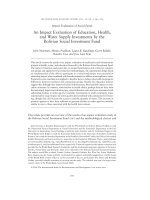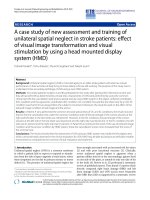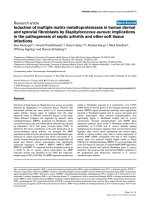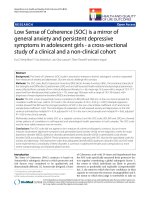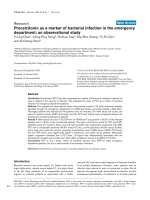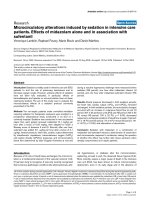non accidental non fatal poisonings attended by emergency ambulance crews an observational study of data sources and epidemiology
Bạn đang xem bản rút gọn của tài liệu. Xem và tải ngay bản đầy đủ của tài liệu tại đây (898.23 KB, 8 trang )
Open Access
Research
Non-accidental non-fatal poisonings
attended by emergency ambulance
crews: an observational study of
data sources and epidemiology
Ann John,1 Chukwudi Okolie,1 Alison Porter,1 Chris Moore,2 Gareth Thomas,1
Richard Whitfield,2 Rossana Oretti,3 Helen Snooks1
To cite: John A, Okolie C,
Porter A, et al. Nonaccidental non-fatal
poisonings attended by
emergency ambulance crews:
an observational study of
data sources and
epidemiology. BMJ Open
2016;6:e011049.
doi:10.1136/bmjopen-2016011049
▸ Prepublication history and
additional material is
available. To view please visit
the journal ( />10.1136/bmjopen-2016011049).
Received 5 January 2016
Revised 18 July 2016
Accepted 19 July 2016
1
Swansea University Medical
School, Swansea, UK
2
Welsh Ambulance Services
NHS Trust, H.M.Stanley
Hospital, St Asaph,
Denbighshire, UK
3
Community Addiction Unit,
Cardiff and Vale University
Health Board, Cardiff, UK
Correspondence to
Dr Ann John;
ABSTRACT
Background: Non-accidental non-fatal poisoning
(NANFP) is associated with high risk of repeat
episodes and fatality. This cross-sectional study
aims to describe the data sources and epidemiology of
non-fatal poisonings (NFPs) presenting to the
emergency ambulance service.
Methods: We assessed incidents of NFP across Wales
from electronic ambulance call centre records and
paper records completed by attending ambulance
crews, December 2007 to February 2008. We
descriptively analysed data completed by attending
crews.
Results: 92 331 calls were made to the ambulance
call centre, of which 3923 (4.2%) were coded as
‘overdose’ or ‘poisoning’. During the same period,
ambulance crews recorded 1827 attended NANFP
incidents in those categories, of which 1287 (70.4%)
had been identified in the call centre. 76.1% (1356/
1782) were aged 15–44 years and 54.2% (991/1827)
were female. 75.0% (1302/1753) of incidents
occurred in areas from the lower 2 quintiles of
deprivation in Wales. Substance taken was reported in
90% of cases (n=1639). Multiple ingestion was
common (n=886, 54.1%). Psychotropic was the most
frequently taken group of substances (n=585, 32.0%)
and paracetamol (n=484, 26.5%) was the most
frequently taken substance prehospital. Almost half of
patients had taken alcohol alongside other substances
(n=844, 46.2%). Naloxone was the most frequently
administered treatment (n=137, 7.5%). Only
142/1827 (7.8%) patients were not transported to
hospital, of whom 4 were recorded to have been
given naloxone.
Conclusions: We report new data on the
epidemiology of NFP across substance types at
national level, highlighting deficiencies in information
systems and high levels of multiple ingestion. In
order to develop policy and practice for this patient
group prehospital and further along the care pathway,
information systems need to be developed to allow
accurate routine monitoring of volume, presentation
and outcomes.
Strengths and limitations of this study
▪ This is the first study to present a picture of
ambulance service attendance to incidents of
non-accidental non-fatal drug poisonings in the
UK. Only preliminary studies have so far been
published of prehospital non-fatal poisonings
using ambulance call centre data, many of which
are limited by age of participants or substance
ingested.
▪ This study is whole population-based with an
ambulance service covering all of Wales.
▪ This study relied on data from ambulance crews
captured in the unstructured narrative section of
the patient clinical records (PCR). This was not
verified independently in this study. PCRs also
had missing and unreadable data.
BACKGROUND
Non-fatal poisonings (NFPs) are a major
global public health issue and a considerable
economic burden.1 They is one of the commonest reasons for general hospital admission in the UK, with Wales alone having a
total of 7415 hospital admissions for NFPs in
2009.2 Almost all of this care is unscheduled,
that is, unplanned, urgent or emergency.
NFP pose a challenge to health services capacity to plan, provide and deliver care. Many
NFPs are non-accidental and may be selfharm (intentional self-poisoning or selfinjury irrespective of motivation or intent to
die)—although there are challenges to identifying which NFP can be defined as selfharm. Self-harm brings an increased risk of
repeat episodes1 and potentially of suicide.3
Physical health and life expectancy are also
severely compromised compared with the
general population in those who self-harm.4
Emergency ambulance services will often be
the first point of contact with health services
John A, et al. BMJ Open 2016;6:e011049. doi:10.1136/bmjopen-2016-011049
1
Open Access
for someone who has experienced a NFP who seeks help
or help is sought for them. Optimal prehospital care is set
out in the National Institute for Health and Care
Excellence (NICE) guidelines,5 supported by clinical standards produced by the Royal College of Psychiatrists for all
health professionals6 and a set of clinical practice guidelines developed specifically for UK ambulance services by
the Joint Royal Colleges Ambulance Liaison Committee
( JRCALC).7 These recommend transport to hospital
unless the patient refuses, and provide advice for ambulance crews on treating poisonings where appropriate, for
example, through the use of naloxone, which counteracts
the effects of opioids. Studies in Australia8 and Norway9
have highlighted the role of ambulance services in providing treatment on scene, in particular for opioid poisonings. The use of emetics and activated charcoal was not a
prehospital option at the time of this study and are
unlikely to become so because of the difficulty of administration and risk of aspiration.8 9
Ambulance service records have the potential to
provide useful data to improve our understanding of the
epidemiology of non-accidental non-fatal poisonings
(NANFPs) and to help plan services. Only preliminary
studies have so far been published in this field,10–12 and
they are limited in terms of the age of participants (11–
44 years) or substance (opioid overdose with naloxone
treatment).11–13 In the UK, the main source of data on
ambulance service activity is information gathered at the
call centre, which is based on data provided by emergency ambulance service callers, coded clinically using
structured prioritisation algorithms, with management
information about vehicle dispatch and response times.
These systems provide data for performance management, policy development, implementation and monitoring, at national and local levels, although the
accuracy of clinical data has been found to be low.13 14
In addition, crews collect data when they attend the
patient, recording it either on a paper form or in an
electronic record. No study has assessed the accuracy of
data sources, that is, call centre data compared with data
collected by attending ambulance crews when describing
the epidemiology of NFP or more particularly NANFP.
While there is a relatively clear picture of the epidemiology of the nearly 3000 fatal poisonings which occur in
England and Wales every year,15 there is little research evidence nationally or internationally concerning the epidemiology of NANFPs attended by emergency ambulance crews.
2. Demographic and clinical presentation of NANFPs
attended by emergency ambulance: substance(s)
taken; level of consciousness of patient; whether the
patient had also consumed alcohol; incidence of violence; elicited suicidal ideation; presence of police;
prehospital treatment; call outcome.
METHODS
Study design
We carried out this observational study of emergency
ambulance service calls and attendances in the whole of
Wales between December 2007 and February 2008. The
study was commissioned by the Welsh Government in
response to concerns raised, during the routine national
drug-related death inquiry into deaths from poisoning
(South Wales Drug Related Deaths Review Group.
Personal communication. 28 February 2008), about the
lack of information relating to the volume and patterns
of presentation of NFPs to emergency services. It was
part of a wider programme of research on drugs and the
ambulance service carried out by Swansea University for
the Welsh Government.
Research Ethics Committee approval was not required
as the project was categorised as service evaluation (confirmed by Local Research Ethics Service, 2009).
Study setting
The Welsh Ambulance Services National Health Service
(NHS) Trust (WAST) provides emergency ambulance
services to the country’s population of ∼3 million.16
WAST formally adopted the JRCALC guidelines on poisoning in adults in January 2008, and had previously
worked to locally developed guidelines.
Objectives
To describe:
1. Pre-hospital emergency information systems in relation to identification and management of NFPs and
NANFPs;
Data sources and items
Data related to emergency ambulance service calls were
stored in two systems used by WAST. Data related to the
call itself, as recorded by the call taker in the call centre,
were held electronically and were available for analysis: call
takers in the ambulance call centre followed a structured
prioritisation algorithm (Advanced Medical Priority
Dispatch System—AMPDS)13 in order to allocate a clinical
and urgency code to each call, and also recorded the
response of the service to the call. The second data system
consisted of paper forms (patient clinical records—PCRs)
completed by attending crews at the incident. The PCRs
included identifying data, demographics and clinical
details of patient condition and any treatments provided.
PCRs were mostly structured forms, with tick boxes for
many data items related to clinical assessment and treatment. However, some items of interest to this study, such
as, substance taken and suicidal ideation, were only
recorded by crews in a free-text narrative section (see
online supplementary file 1). The PCR forms were collated
at ambulance stations and sent monthly to a central location for scanning and storage. Images were individually
retrievable by searching by incident number, which was a
common field with the emergency call centre data set.
2
John A, et al. BMJ Open 2016;6:e011049. doi:10.1136/bmjopen-2016-011049
AIM AND OBJECTIVES
Aim
To describe the data sources and epidemiology of
NANFPs attended by emergency ambulance.
Open Access
WAST’s two parallel information systems were not
electronically linked, so incidents and individuals cannot
be tracked across the two systems in this way. However,
when the incident is handed over to paramedics to
attend the call handler will supply their assigned AMPDS
code and this is recorded on the PCR. Since both systems
use different condition categories and coding systems, at
the outset of the study the research team had to define
which codes were relevant to the study from each data
set. We included calls coded in the ambulance call centre
as ‘overdose/poisoning’ (AMPDS Code 23) but were
unable to distinguish accidental and non-accidental overdose or poisoning in the AMPDS call taker system. We
included PCRs with relevant clinical codes or treatment:
‘substance abuse’ (Code D002), ‘overdose’ (Code D003),
‘naloxone administered’ (Code NLX), excluding accidental poisoning or overdose (Code T047). We did not
include incidents where alcohol was the only reported
substance taken (Code D001).
For the purposes of further analysis, PCR data were
taken as the ‘gold standard’, since these were recorded
by the ambulance clinician attending the patient
face-to-face. We extracted data recorded about: substances ingested; consciousness level of patient; whether
the patient had also consumed alcohol; incidence of violence or suicidal ideation; presence of police; prehospital treatment; call outcome.
coding frame developed for the study in collaboration
with clinical members of the team (see online supplementary file 2—free-text coding frame), with validation
by double coding of a sample of 10% of the entire
data set.
Data analysis
Data from the AMPDS and PCRs were then exported for
descriptive statistical analyses into SPSS V.16.
Analysis and reporting of data are in accordance with
STROBE guidelines.19
This study was commissioned by the Welsh Government
(CONTRACT 206/2003) but the funder played no role
in its design, interpretation or the writing of the report.
Study population
We gathered data on all incidents in Wales for which an
emergency ambulance service call coded as being for
‘overdose/poisoning’ (AMPDS Code 23) was made in
the period from 1 December 2007 to 29 February 2008,
and those incidents attended by ambulance crews in the
same period where records completed by crews indicated that the patient had experienced a NANFP.
RESULTS
Comparison of call centre and PCR data
Calls categorised on AMPDS at the call centre as overdose or poisoning made up 4.2% of emergency calls to
the ambulance service in Wales during the study period
(3923/92 331). During the same period, ambulance
crews completed 1843 PCR forms categorised by their
attending crew as ‘substance abuse’, ‘overdose’ or where
naloxone was administered. Sixteen of these were duplicates and were excluded. In total, 1827 incidents
attended were therefore included in the analysis (figure 1).
Only one-third of calls (1287/3923) coded as NFPs in
the ambulance call centre were confirmed as NANFPs
by attending crews (table 1). Conversely 540 cases classified by crews as NANFP had not been identified in the
call centre as NFPs, but had been assigned other codes
across a wide range of categories (table 2), the most frequent being unknown (189, 35.0%), unconscious/fainting (73, 13.5%), psychiatric behaviour (71, 13.1%) and
breathing problems (34, 6.3%).
Data extraction and measures
Call centre data were cleaned to ensure that multiple
calls or responses per patient were matched and that
hoax, cancelled or other abortive calls were excluded.
We coded information from the PCRs (both structured and free text) on demography, clinical presentation, treatment and outcomes and entered it to an
Access 2007 database. We extracted postcodes for the
location of each incident, and categorised these postcodes using the Welsh Index of Multiple Deprivation
(WIMD)17 and the Rural and Urban Area Classification
(RUAC).18 WIMD is a lower super output area measure
of deprivation based on eight domains including
income, health and education and reported as quintiles/fifths of deprivation. RUAC categorises areas at
output area level by density of population into ‘urban’,
‘town and fringe’ or ‘village, hamlet and isolated dwellings’. Unstructured/free-text information relevant to the
study, including details of the substance taken, aggressive
behaviour and police presence was independently coded
by three research team members (RO, AP, GT) using a
Patterns of presentation of cases: analysis of NANFP PCRs
Demographics
In total, 54.2% (991/1827) of the patients attended
were female. In 45 patients the age was not recorded.
The mean age of all patients was 33.9 years (IQR 22–
39 years) with a range of 1–95 years. The majority of
patients (76.1%; 1356/1782) were within the 15–44 age
range, 33.6% (598/1782) were aged 15–24 years and
0.4% (8/1782) were recorded as aged <4 years.
Seventy-four (4.1%) of the 1827 PCR records collected
were excluded from the area-level analyses because
either there was no valid incident postcode recorded
(n=68) or the incident took place outside Wales (n=6).
The vast majority of incidents occurred in areas in the
two most deprived quintiles: 614/1753 (35.0%) in the
most deprived fifth, 688/1753 (40.0%) in the second
most deprived fifth. Only 126/1753 (8%) of incidents
occurred in areas in the two least deprived quintiles.
Most incidents were attended in the more populated
urban areas of Wales (settlements with a population over
10 000; 1346/1753, 76.8%).
John A, et al. BMJ Open 2016;6:e011049. doi:10.1136/bmjopen-2016-011049
3
Open Access
Figure 1 Calls categorised as non-fatal poisonings in the ambulance call centre and by ambulance crews on scene.
Clinical/incident characteristics
A wide range of substances were recorded on PCRs as
having been taken by patients during the incident
attended that were included in the study. Results are presented by substance taken with substances reported by
group and name. Any one individual associated with an
attended incident may appear more than once if more
than one substance was ingested (table 3). Psychotropics
were the most frequently reported group of substances,
taken by 585/1827 (32.0%) of patients. Paracetamol was
the most frequently reported substance, taken by 484/
1827 (26.5%) of patients. In 188/1827 (10.3%) of
patients the substance or substances taken was either not
known or not recorded. In the remaining 1639 patients,
if alcohol is disregarded: 753 (45.9%) ingested only one
substance, 886 (54.1%) ingested two or more. The most
frequent combinations were: paracetamol and opioids
(137/1639, 8.4%), paracetamol and non-steroidal antiinflammatory medication (91/1639, 5.6%), psychotropics and opioids (86/1639, 5.2%), paracetamol and psychotropics (79/1639, 4.8%). Alcohol had been taken
alongside other substances by 844/1827 (46.2%)
patients in incidents attended.
Ambulance crews recorded Glasgow Coma Scale
(GCS) scores for 1746/1827 (95.6%) of the patients
attended. The majority were fully conscious (1416/1746,
81.1%), with a GCS of 15. However, ∼5% were unconscious with GCS scores ≤8 (83/1746). Most of those with
scores of ≤8 had GCS scores of 3, that is, were categorised unresponsive when the ambulance arrived (63/
1746, 3.6%). This was mostly associated with substances
taken with alcohol (21/63, 33.3%) and/or opioids (19/
Table 1 Number of overdose/poisoning codes assigned in the call centre and NANFP or treated with naloxone assigned on
PCR forms
Call centre subcategory
code
23D01
23D02
23C01
23C02
23C03
23C04
23C05
23C06
23C07
23C08
23C09
23B01
23O01
23 other
Total
Description
Unconscious
Severe respiratory distress
Violent
Not alert
Abnormal breathing
Antidepressants
Cocaine or derivative
Heroin
Acid or alkali
Third party caller
Poison control
Overdose without priority
symptoms
Poisoning without priority
symptoms
Number of call
centre calls
Number of NANFP attendances from
PCR (% of NFP call centre codes)
477
10
497
675
299
121
7
26
3
831
7
797
158 (33.1)
2 (0.2)
200 (40.2)
176 (26.1)
69 (23.1)
52 (43.0)
5 (71.4)
6 (23.1)
2 (66.7)
203 (24.4)
0
337 (42.3)
173
21 (12.1)
3923
56
1287
NANFP, non-accidental non-fatal poisoning; NFP, non-fatal poisoning; PCR, patient clinical record.
4
John A, et al. BMJ Open 2016;6:e011049. doi:10.1136/bmjopen-2016-011049
Open Access
Table 2 Non-overdose codes assigned in the call centre
to patients then coded by attending crews as
non-accidental overdose/poisoning or treated with
naloxone (n=540)
Call centre
code
01
02
04
05
06
09
10
12
13
17
18
19
20
21
22
25
26
27
28
29
30
31
32
Not known/
not recorded
Total
Description
Abdominal pain/
problems
Allergies
Assault/sexual
assault
Back pain
Breathing
problems
Cardiac/
respiratory arrest
Chest pain
Convulsion/fitting
Diabetic
problems
Falls
Headache
Heart problems
Exposure
Haemorrhage/
laceration
Industrial
accident
Psychiatric
behaviour
Sick person
Stab/gunshot
Stroke
Traffic accident
Traumatic
injuries
Unconscious/
fainting
Unknown
problem
Number of NANFP
calls from PCR data
(% of all those
miscoded or not
labelled NFP at call)
4 (0.7)
2 (0.4)
5 (0.9)
1 (0.2)
34 (6.3)
18 (3.3)
18 (3.3)
28 (5.2)
4 (0.7)
15 (2.8)
1 (0.2)
4 (0.7)
1 (0.2)
10 (1.9)
10 (1.9)
71 (13.1)
21 (3.9)
5 (0.9)
3 (0.6)
1 (0.2)
3 (0.6)
73 (13.5)
19 (3.5)
189 (35.0)
540 (100)
NANFP, non-accidental non-fatal poisoning; NFP, non-fatal
poisoning; PCR, patient clinical record.
behaviour was recorded in an even smaller number of
attendances (52/1827, 2.8%). The police were recorded
as present in 9.6% (175/1827) of attendances, and
alcohol combined with at least one substance was associated with half of these (84/175, 48.0%).
Only 142/1827(7.8%) patients in the incidents
attended were not transported to hospital, of which
almost half (71) were recorded as having refused transport. The largest number of patients not conveyed to
hospital had taken opioids (32/429, 7.5%), of whom 4
were recorded to have been given naloxone. However,
the highest rates of non-conveyance were found in incidents where the substance ingested was either not
known (14/141, 9.9%) or not stated (11/47, 23.4%).
The highest demand for emergency ambulance services for poisonings was during ‘out-of-hours’ times. Out
of 1182 incidents recorded on PCRs as NFPs, which
recorded both a time and a date, 797 (67.4%) had been
attended either between 18:30 and 8:00, at the weekend,
or on a bank holiday. Of the 1821 PCRs where a date
was recorded, 615 (33.8%) took place at the weekend,
with Saturdays having the highest number of contacts
with the ambulance service relating to NFPs (334,
18.3%).
DISCUSSION
Key findings
This is the first study to present a picture of ambulance
service attendance to incidents of NANFP in the UK. We
found the electronic data captured by ambulance
service call centre AMPDS is not a reliable indicator of
the incidence of NFP. This has implications for service
planning for emergency care. The AMPDS was not
designed as diagnostic tool, but as a way to rapidly identify and prioritise calls about life-threatening conditions.13 The information received by the call taker may
well be incomplete. It is therefore unsurprising that
ambulance call centre data record substantially higher
numbers of NFPs than those identified on scene by
attending ambulance crews. Conversely nearly one-third
of those NFPs identified at scene are not those identified at the time the call is made. The quality of data
recorded on PCRs was variable. Structured clinical
assessment and treatment data were completed fully, but
unstructured free-text data were of variable quality and
completeness.
63, 30.2%). Medication was recorded as being administered by crews to 137/1827 (7.5%) patients. Naloxone
was administered to 102 (5.6%) of these individuals,
with more than one dose being administered on more
than half of these occasions (69/102). Other medication
administered by ambulance crews included metoclopramide, furosemide, glucagon, atropine, diazepam and
epinephrine. Fluids were recorded as being administered to 17/1827 individuals (0.9%).
Suicidal ideation was recorded in only 175/1827
(9.6%) of incidents attended. Aggressive or violent
Strengths and limitations of the study
In this study, we report NFPs for which an emergency
call was made. We do not know the proportion of all
NFPs that this represents. People do not always present
to emergency services, and routine recording of attendance at emergency department (ED) at the time of this
study was unreliable and incomplete. Hence, the proportion of all NFPs is difficult to determine. A strength of
this study is that it is whole population-based with an
ambulance service covering the nation of Wales.
John A, et al. BMJ Open 2016;6:e011049. doi:10.1136/bmjopen-2016-011049
5
Open Access
6
Table 3 Characteristics of incidents of non-accidental non-fatal poisoning, by substance(s) ingested
John A, et al. BMJ Open 2016;6:e011049. doi:10.1136/bmjopen-2016-011049
Substance
Number of
people who
had taken
substance
N (%)
Any
Psychotropics
Antidepressants
Benzodiazepines
Antipsychotics
Paracetamol
Opiates
Codeine
Diamorphine
Buprenorphine
Methadone
Morphine
NSAIDs
Ibuprofen
Aspirin
Diclofenac
Other known
Cocaine
Amphetamine
Cannabis
Ecstasy
Anticonvulsants
Cardiovascular
Antimicrobials
Indigestibles
Not known
Not stated
1827 (100.0)
585 (32.0)
322 (17.6)
279 (15.3)
65 (3.6)
484 (26.5)
429 (23.5)
266 (14.6)
101 (5.5)
57 (3.1)
14 (0.8)
12 (0.7)
223 (12.2)
154 (8.4)
47 (2.6)
38 (2.1)
226 (12.4)
60 (3.3)
36 (2.0)
36 (2.0)
34 (1.9)
32 (1.8)
23 (1.3)
16 (0.9)
11 (0.6)
141 (7.7)
47 (2.6)
Female
N (%)
Reduced
consciousness
(GCS≤8)
Age
Mean N (%)
Alcohol
N (%)
Aggression
or violence
N (%)
Suicidal
ideation
N (%)
Police
present
N (%)
Refused
treatment
N (%)
Refused
transport
N (%)
Taken to
hospital
N (%)
991 (54.2)
322 (55.0)
177 (55.0)
157 (56.3)
37 (56.9)
253 (52.3)
240 (56.0)
149 (56.0)
59 (58.4)
30 (52.6)
9 (64.3)
7 (58.3)
118 (52.9)
85 (55.2)
21 (44.7)
20 (52.6)
130 (57.5)
29 (48.3)
20 (55.6)
20 (55.6)
17 (50.0)
18 (56.3)
10 (43.5)
16 (100.0)
10 (90.9)
68 (48.2)
32 (68.1)
33.85
33.56
33.55
33.77
33.41
34.85
33.28
34.65
30.64
32.62
26.50
32.50
35.15
36.28
33.68
34.34
35.00
31.81
37.23
35.21
33.68
37.76
33.05
37.53
40.36
34.45
34.22
844 (46.2)
316 (54.0)
164 (50.9)
162 (58.1)
24 (36.9)
219 (45.3)
181 (42.2)
134 (50.4)
25 (24.8)
20 (35.1)
6 (42.9)
4 (33.3)
112 (50.2)
83 (53.9)
17 (36.2)
20 (52.6)
100 (44.3)
35 (58.3)
15 (41.7)
17 (47.2)
22 (64.7)
7 (21.9)
8 (34.8)
4 (25.0)
5 (45.5)
14 (9.9)
0 (0.0)
52 (2.9)
22 (3.8)
15 (4.7)
10 (3.6)
3 (4.6)
19 (3.9)
24 (5.6)
15 (5.6)
2 (2.0)
0 (0.0)
0 (0.0)
0 (0.0)
8 (3.6)
4 (2.6)
0 (0.0)
4 (10.5)
10 (4.4)
3 (5.0)
1 (2.8)
3 (8.3)
1 (2.9)
0 (0.0)
0 (0.0)
0 (0.0)
0 (0.0)
4 (2.8)
0 (0.0)
147
62
40
30
2
30
42
36
3
3
1
0
29
21
6
3
7
0
2
1
0
3
1
0
0
8
2
175
59
37
31
7
47
38
25
6
4
2
1
20
13
4
6
25
6
5
4
5
2
2
3
0
12
6
20 (1.1)
6 (1.0)
2 (0.6)
4 (1.4)
2 (3.1)
7 (1.5)
5 (1.2)
4 (1.5)
0 (0.0)
1 (1.8)
0 (0.0)
0 (0.0)
2 (0.9)
1 (0.7)
0 (0.0)
1 (2.6)
2 (0.9)
1 (1.7)
0 (0.0)
1 (2.8)
0 (0.0)
0 (0.0)
0 (0.0)
0 (0.0)
0 (0.0)
0 (0.0)
1 (2.1)
71 (3.9)
22 (3.8)
10 (3.1)
10 (3.6)
5 (7.7)
24 (5.0)
16 (3.7)
7 (2.6)
2 (2.0)
7 (12.3)
1 (7.1)
0 (0.0)
6 (2.7)
6 (3.9)
0 (0.0)
0 (0.0)
13 (5.8)
3 (5.0)
1 (2.8)
0 (0.0)
1 (2.9)
0 (0.0)
0 (0.0)
5 (31.3)
5 (45.5)
5 (3.6)
3 (6.4)
1685 (92.2)
559 (95.6)
307 (95.3)
267 (95.7)
62 (95.4)
463 (95.7)
397 (92.5)
253 (95.1)
88 (87.1)
53 (93.0)
10 (71.4)
12 (100.0)
209 (93.7)
144 (93.5)
44 (93.6)
36 (94.7)
208 (92.0)
54 (90.0)
35 (97.2)
31 (86.1)
31 (91.2)
30 (93.8)
23 (100.0)
15 (93.8)
10 (90.9)
126 (89.4)
36 (76.6)
83 (4.5)
22 (3.8)
12 (3.7)
12 (4.8)
3 (4.6)
29 (6.0)
24 (5.6)
16 (6.0)
5 (5.0)
2 (3.5)
2 (14.3)
0 (0.0)
8 (3.6)
4 (2.6)
2 (4.3)
2 (5.3)
10 (4.4)
4 (6.7)
0 (0.0)
1 (2.8)
1 (2.9)
2 (6.3)
3 (13.0)
0 (0.0)
0 (0.0)
6 (4.3)
0 (0.0)
(8.1)
(10.6)
(12.4)
(10.8)
(3.1)
(6.2)
(9.8)
(13.5)
(3.0)
(5.3)
(7.1)
(0.0)
(13.0)
(13.6)
(12.8)
(7.9)
(3.1)
(0.0)
(5.6)
(2.8)
(0.0)
(9.4)
(4.4)
(0.0)
(0.0)
(5.7)
(4.3)
(9.6)
(10.1)
(11.5)
(11.1)
(10.8)
(9.7)
(8.9)
(9.4)
(5.9)
(7.0)
(14.3)
(8.3)
(9.0)
(8.4)
(8.5)
(15.8)
(11.1)
(10.0)
(13.9)
(11.1)
(14.7)
(6.3)
(8.7)
(18.8)
(0.0)
(8.5)
(12.8)
Note: multiple ingestion was common; therefore, the sum for ingestion of individual substances does not add up to the collective total of the group to which the substance ingested belongs.
GCS, Glasgow Coma Scale; NSAIDs, non-steroidal anti-inflammatory drugs.
Open Access
However, we were unable to track incidents and individuals across the two information systems (call centre and
PCR) because they are not electronically linked.
Assigned call centre codes are recorded on PCRs when
the call handler contacts the ambulance crew to handover the incident.
This study relied on data recorded by ambulance
crews concerning substances taken, captured in the
unstructured narrative section of the PCR. This was not
verified independently in this study. We reported
attended incidents across the study period not individuals, since this was not facilitated by the paper-based
format. PCRs also had missing and unreadable data. As
previous studies both in the UK and internationally have
shown,9 ambulance service records are frequently
incomplete, making it hard to get a complete picture of
the clinical presentation of patients, their demography
or patterns of care provision. Thus, reliance on manual
sorting of cases by ambulance service staff may have
introduced some inaccuracy into findings. Unlike previous studies of NFPs in the setting of a hospital ED,20 21
the research team did not have access to reliable, searchable electronic data. In those ambulance services which
have moved from paper PCRs to electronic reporting
systems, processes of data retrieval and management are
likely to be far more straightforward than in the Welsh
Ambulance Services Trust, although the impact of this
on completeness of data has yet to be assessed.
predictors of adverse clinical features.12 We found that
naloxone was administered to 5.6% of NFPs attended
which is similar to the 6.2% found in a much larger
study by Faul et al.25 Previous studies have shown an association between NFP and subsequent death from poisoning.22 24 In 2007, 189 people died of drug-related
poisoning in Wales, the majority of whom (70%; 132/
189) were male.15
This is the first study, to the best of our knowledge, in
the UK to compare call centre data and data collected
by attending ambulance crews for NFP and then to
describe the epidemiology of NFP prehospital. Cantwell
et al26 compared call centre data based on a triage algorithm with paramedic assessment in relation to falls and
also found discrepancies across the two systems,
although in this clinical area call data underestimated
the true incidence by up to 13%.
Comparison with previous studies
Most current literature in this field relates to ED attendance and hospital admission and the distribution of substances ingested and the association with alcohol found
in this study is consistent with these studies.6 7 9 22
Previous studies have also shown that most self-harm ED
attendances occur out-of-hours between 17:00 and 9:00
when those who self-harm are less likely to receive a psychosocial assessment than those attending between 9:00
and 17:00 with many leaving before being seen by any
clinical staff.23 Psychosocial assessments of needs are
recommended by NICE8 and associated with reduced
repetition. However, those at greatest risk of repetition
are least likely to receive these assessments.22
In Wales, the majority of patients attended with
NANFP were transported to hospital. This is a very different picture from, for example, Norway where one
study found that 40% of people who were attended for
NFP, the majority of whom were poisoned with opioids,
were left at scene after treatment.9 This contrasts with
only 7.8% in our study, and may reflect different
working practices across countries or higher conveyance
rates in those where poisoning is non-accidental.
In keeping with other studies,9 24 this study found that
NFPs are experienced by both genders, predominately
aged 15–44 years and taking psychotropic medication,
paracetamol or opioids. One smaller study of 585
patients assessed ambulance crew data only and found
being male and ingesting opioids were important
Implications for policy, practice and further research
This study brings into focus a number of issues that practitioners and policymakers need to address. It suggests
that ambulance service data contain a wealth of useful
data for studying the epidemiology of NFPs and in turn
supporting the planning of future harm minimisation
strategies, for measuring the success of interventions
and for supporting ambulance crews in their role in
relation to NFPs. However, current data systems do not
readily support this. The more accurate and complete
data recorded on scene by ambulance clinicians is gathered in WAST, as in many other UK ambulance services,
on a paper record, and so is not readily collated,
searched or interrogated. Much of the detail is recorded
in the narrative section, rather than in tick box format,
and so accessing it entails reading handwriting as well as
interpreting and coding information which is likely to
be non-standardised.
If PCRs cannot routinely be assessed and analysed as
an alternative to call centre data, then there is a clear
absence of robust data, placing risk management and
injury prevention programmes at danger of being poorly
informed and inadequately conceptualised. One way of
rectifying this may be the introduction of electronic
PCRs, but progress on this in Wales has been hampered
by lack of funding, lack of central direction and a shortage of network capacity. An alternative option which has
been recently approved in Wales is the introduction of a
digital pen, for use by ambulance clinicians. This offers
a novel method of capturing handwritten data, which
can be recorded and analysed electronically. This shift
to electronic PCRs is underway in other ambulance services and to be welcomed. However, the issues relating
to coding and the accuracy of triage systems in call
centre records identified in this study will require continued assessment and quality improvement. Once electronic capture is achieved, there is a further need to
invest in information systems that link call and on scene
information/patients who make multiple calls/and
John A, et al. BMJ Open 2016;6:e011049. doi:10.1136/bmjopen-2016-011049
7
Open Access
prehospital and ED data to improve our understanding
of individuals help-seeking behaviour and outcomes.
The out-of-hours of presentation found in this study
has resource implications for ambulance, ED, psychiatric
services, primary care managers and unscheduled care
providers. These services need to be organised, so that
NFP patients who attend ED or who are not transported
can receive signposting to appropriate services for assessment, thereby reducing the risk for future repetition
and identifying their needs. Future research should
include assessment of the delivery of interventions in
the prehospital setting.
5.
6.
7.
8.
9.
10.
11.
CONCLUSIONS
Ambulance staff are often the first point of contact for
those who self-poison, and this contact offers an opportunity for intervention. This study highlights that current
policy, service organisation and delivery is being based
on unreliable call centre data. More accurate and complete data are recorded on scene by ambulance staff.
Traditionally, it has been recorded on paper with the
use of free text, and so has been impractical for routine
use to support analysis. The benefits of reliable, routinely collected electronic information are likely to be
many. They could influence national strategies and policies as well as provide information on the needs of individuals, the design of prehospital interventions and
improve service planning for unscheduled care.
Contributors All of the authors contributed to the conception and design of
the study. RO, GT and AP contributed to data collection. AP, GT and AJ
contributed to data analysis. AJ, AP, and CO prepared the manuscript. All
authors approved the publication of the study.
Funding National Institute for Social Care and Health Research (NISCHR)—
Swansea Trials Unit RFS-12.
Competing interests None declared.
12.
13.
14.
15.
16.
17.
18.
19.
20.
Provenance and peer review Not commissioned; externally peer reviewed.
Data sharing statement No additional data are available.
Open Access This is an Open Access article distributed in accordance with
the Creative Commons Attribution Non Commercial (CC BY-NC 4.0) license,
which permits others to distribute, remix, adapt, build upon this work noncommercially, and license their derivative works on different terms, provided
the original work is properly cited and the use is non-commercial. See: http://
creativecommons.org/licenses/by-nc/4.0/
REFERENCES
1.
2.
3.
4.
8
Owens D, Horrocks J, House A. Fatal and non-fatal repetition
of self-harm systematic review. Br J Psychiatry 2002;181:193–9.
CAPIC. The burden of injury in Wales. Public Health Wales NHS
TRUST, 2012.
Meltzer H, Lader D, Corbin T, et al. Non-fatal suicidal behaviour
among adults aged 16 to 74 in Great Britain. London: Stationery
Office, 2002.
Bergen H, Hawton K, Waters K, et al. Premature death after
self-harm: a multicentre cohort study. Lancet 2012;380:1568–74.
21.
22.
23.
24.
25.
26.
NICE. Understanding NICE guidance: treatments for drug misuse.
London: NICE, 2007.
Royal College of Psychiatrists. Better services for people who
self-harm: quality standards for healthcare professionals. 2006.
/>pdf (accessed 12 August 2016).
Joint Royal Colleges Ambulance Liaison Committee. UK Ambulance
Services Clinical Practice Guidelines 2013. 3rd edn. Class
Publishing Ltd, London. 2013.
Dietze P, Jolley D, Cvetkovski S, et al. Characteristics of non-fatal
opioid overdoses attended by ambulance services in Australia.
Aust N Z J Public Health 2004;28:569–75.
Heyerdahl F, Hovda KE, Bjornaas MA, et al. Pre-hospital treatment
of acute poisonings in Oslo. BMC Emerg Med 2008;8:15.
Degenhardt L, Hall W, Adelstein BA. Ambulance calls to suspected
overdoses: New South Wales patterns July 1997 to June 1999.
Aust N Z J Public Health 2001;25:447–50.
Bammer G, Ostini R, Sengoz A. Using ambulance service records to
examine nonfatal heroin overdoses. Aust J Public Health
1995;19:316–17.
Gwini SM, Shaw D, Mohammad I, et al. 013 Factors associated with
adverse clinical features in patients presenting with non-fatal
self-poisoning. Emerg Med J 2011;28:e1.
Deakin CD, Sherwood DM, Smith A, et al. Does telephone triage of
emergency (999) calls using advanced medical priority dispatch
(AMPDS) with Department of Health (DH) call prioritisation
effectively identify patients with an acute coronary syndrome? An
audit of 42657 emergency calls to Hampshire Ambulance Service
NHS Trust. Emerg Med J 2006;23:232–5.
Deakin CD, Alasaad M, King P, et al. Is ambulance telephone
triage using advanced medical priority dispatch protocols able to
identify patients with acute stroke correctly? Emerg Med J
2009;26:442–5.
Deaths related to drug poisoning in England and Wales, 2003–07.
Health Stat Q 2008;39:82–8. www.ons.gov.uk/.../subnational.../
deaths-related-to-drug-poisoning/2009. (accessed 12 August 2016).
Office for National Statistics. Deaths related to drug poisoning in
England and Wales, Statistical Bulletin, 2009. 24th August 2010.
Welsh Government. Welsh Index of Multiple Deprivation 2011. 2011.
es/docs/statistics/2011/111222wimd11techen.pdf.
(accessed 12 August 2016).
The Countryside Agency. Rural and Urban Area Classification 2004.
2004. />http:/defra.gov.uk/evidence/statistics/rural/documents/ruraldefn/Rural_Urban_Introductory_Guide.pdf. (accessed 12 August
2016).
von Elm E, Altman DG, Egger M, et al. The Strengthening the
Reporting of Observational Studies in Epidemiology (STROBE)
statement: guidelines for reporting observational studies. Prev Med
2007;45:247–51.
Prescott K, Stratton R, Freyer A, et al. Detailed analyses of
self-poisoning episodes presenting to a large regional teaching
hospital in the UK. Br J Clin Pharmacol 2009;68:260–8.
Indig D, Copeland J, Conigrave KM, et al. Characteristics and
comorbidity of drug and alcohol-related emergency department
presentations detected by nursing triage text. Addiction
2010;105:897–906.
Gunnell D, Bennewith O, Peters TJ, et al. The epidemiology and
management of self-harm amongst adults in England. J Public
Health (Oxf ) 2005;27:67–73.
Hickey L, Hawton K, Fagg J, et al. Deliberate self-harm patients who
leave the accident and emergency department without a psychiatric
assessment: a neglected population at risk of suicide. J Psychosom
Res 2001;50:87–93.
Kapur N, Cooper J, Hiroeh U, et al. Emergency department
management and outcome for self-poisoning: a cohort study.
Gen Hosp Psychiatry 2004;26:36–41.
Faul M, Dailey MW, Sugerman DE, et al. Disparity in naloxone
administration by emergency medical service providers and the
burden of drug overdose in US rural communities. Am J Public
Health 2015;105:e26–32.
Cantwell K, Burgess S, Morgans A, et al. Temporal trends in falls
cases seen by EMS in Melbourne: the effect of residence on time of
day and day of week patterns. Injury 2016;47:266–71.
John A, et al. BMJ Open 2016;6:e011049. doi:10.1136/bmjopen-2016-011049


